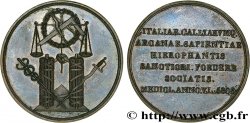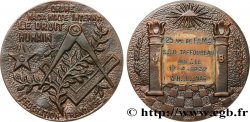fjt_08149 - FREEMASONRY GRAND ORIENT DE FRANCE n.d.
Not available.
Item sold on our e-shop (2010)
Price : 175.00 €
Item sold on our e-shop (2010)
Price : 175.00 €
Type : GRAND ORIENT DE FRANCE
Date: n.d.
Metal : red copper
Diameter : 29 mm
Orientation dies : 6 h.
Edge : cannelée
Rarity : R1
Obverse
Obverse legend : JUNCTI. ROBORANTUR ; À L'EXERGUE : G... O... F....
Obverse description : Faisceau surmonté d'un aigle, cerné de deux palmes.
Obverse translation : Notre union fait notre force.
Reverse
Reverse legend : OMNIBUS. UNUS.
Reverse description : Serpent formant un cercle. Au centre, un niveau avec une tête jeune rayonnante.
Reverse translation : Le seul de tous.
Commentary
La franc-maçonnerie s’implante en France aux alentours du premier quart du XVIIIe s. sous l’influence d’aristocrates anglais. Initiatique, elle est fondée sur le rite hiramique, du nom d’Hiram de Tyr, personnage biblique, architecte du roi Salomon sur le chantier du Temple et qui a résisté à la torture sans livrer ses secrets. Hiram a aussi donné un point de départ du calendrier maçonnique commençant 4000 ans avant le calendrier chrétien. Les symboles servent de signes de reconnaissance entre les initiés, notamment des outils de constructeur de cathédrales (équerre, compas, niveau, maillet, etc.), des formes (triangle, étoile), des nombres (trois, cinq, sept) et des lettres.








 Report a mistake
Report a mistake Print the page
Print the page Share my selection
Share my selection Ask a question
Ask a question Consign / sell
Consign / sell
 Full data
Full data









